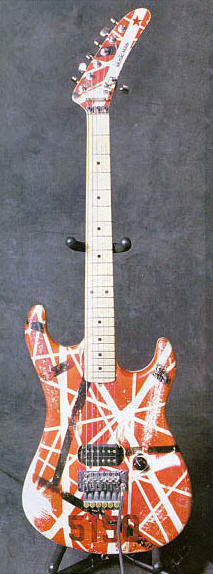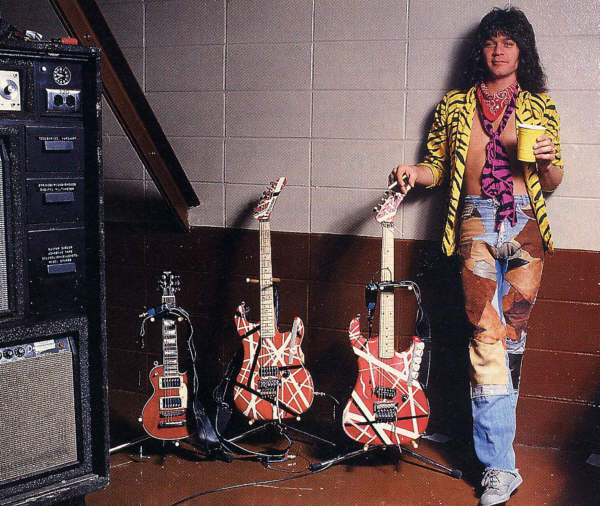The 5150 Guitar is more than just an instrument; it’s a symbol of innovation, raw energy, and the relentless pursuit of sonic perfection in the world of rock guitar. Immortalized in the hands of Eddie Van Halen, this iconic guitar started its journey in 1983, within the workshops of Neptune, New Jersey, marking the beginning of a legend.
Initially conceived in 1983, this guitar, which would later be known as the 5150 guitar, was a product of collaboration and custom craftsmanship. It emerged from the Kramer Guitars factory, a brand synonymous with high-performance rock instruments during the era.
 Close-up of the 5150 guitar body, highlighting the single humbucker pickup and Kramer American Pacer body shape
Close-up of the 5150 guitar body, highlighting the single humbucker pickup and Kramer American Pacer body shape
The body of this future icon was crafted in the distinctive shape that Kramer would later christen the American Pacer. Constructed with a single humbucker route, the wood selection remained somewhat enigmatic. While some sources suggest poplar, aligning with Kramer’s factory practices for Pacers which utilized both maple and poplar, others point towards basswood. This latter theory gains traction considering Eddie Van Halen’s subsequent preference for basswood in his signature guitar designs. The mystery surrounding the body wood adds another layer of intrigue to the 5150 guitar‘s origin story.
The neck was a bespoke creation by Paul Unkert, a luthier renowned for his custom work. Fashioned from a single piece of maple, it featured an unusual asymmetrical back profile, tailored to fit the unique playing style of its intended virtuoso. The headstock shape was directly inspired by the Gibson Explorer, lending a touch of classic rock heritage to this modern instrument. Gotoh 90-degree tuners were chosen for their precision and reliability, essential for maintaining tuning stability even under the most demanding performance conditions.
Adding to its unique specifications, the 5150 guitar was fitted with a rare, early prototype fine-tuner Floyd Rose tremolo system. This particular Floyd Rose is identifiable by its non-centered “Floyd Rose” logo and distinctive brass fine tuners, setting it apart from later iterations. The nut also presented a unique design, differing from standard Floyd Rose nuts of the time, further emphasizing the custom nature of this instrument.
The pickup was another crucial element in the 5150 guitar‘s sonic DNA. Rumored to be a custom-wound Seymour Duncan, it was allegedly based on the classic ’59 model but incorporated an Alnico II magnet for a slightly different tonal character. This custom pickup is believed to be the precursor to the Seymour Duncan Custom Custom model, highlighting the significance of the 5150 guitar in the development of guitar technology.
1983: The Birth Year
In 1983, Paul Unkert meticulously crafted the guitar that would soon become synonymous with the “5150” moniker. This was not a standalone creation but one among several similar guitars commissioned for Eddie Van Halen during this period. Its initial tour of duty commenced in 1984, although it hadn’t yet received the iconic “5150” spacetape treatment.
 Group shot of guitars from 1984 era, illustrating the 5150 guitar amongst similar models
Group shot of guitars from 1984 era, illustrating the 5150 guitar amongst similar models
1983-84: The “5150” Transformation
Sometime between 1983 and 1984, the guitar underwent a visual transformation that would solidify its legendary status. The iconic “5150” spacetape was applied to the body, instantly making it recognizable and cementing its place in rock history as the 5150 guitar. This simple yet striking modification turned a custom instrument into a visual and sonic icon.
The 5150 guitar stands as a testament to the era of innovation and customization in guitar design, forever linked to the groundbreaking sounds of Eddie Van Halen and the vibrant energy of 80s rock. Its journey from a custom-built Kramer to a globally recognized symbol encapsulates a pivotal moment in guitar history.
